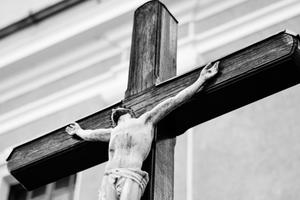May We Always See Who Jesus Is
User’s Guide to the Fourth Sunday of Lent

Sunday, March 19, is the Fourth Sunday of Lent. Mass readings: 1 Samuel 16:1b, 6-7, 10-13a; Psalm 23: 1-3a, 3b-4, 5, 6; Ephesians 5:8-14; John 9:1-41 or John 9:1, 6-9, 13-17, 34-38.
In today’s Gospel, Jesus gives sight to a man born blind. If you are prepared to accept it, you are the man born blind, for all of us were born in darkness and need the enlightenment of baptism. Let’s take a moment and observe the stages evident in this man’s journey to see Christ, for we are the man and these are our stages, too.
“As Jesus passed by he saw a man blind from birth.” This man has no vision. On account of original sin, we as people lost all spiritual vision. We could not see God or endure the light of his glory. This lack of vision causes many to have no “vision” for their life. They don’t know why they were made, or what the true purpose of their existence is. Many cannot see past the sufferings of this world to the glory that waits.
“Go wash in the Pool of Siloam.” The man listened, and went and washed, and came back able to see. Hopefully, you can see baptism here. The Catechism says: The person baptized has been “enlightened”; he becomes a “son of light.” (1216). Notice the man comes back able to see. But just because you’re able to see does not mean you actually do see. Right now I am able to see the Statue of Liberty. But I do not yet see it. I have to make a journey to do that.
“His neighbors … said to him, ‘How were your eyes opened?’ He replied, ‘The man called Jesus made clay and anointed my eyes.’ … And they said to him, ‘Where is he?’ He said, ‘I don’t know.’” So he’s able to see. But his perception is partial. He says, “the man called Jesus.”
He does not know where he is. Hence, although he is able to see, he does not see Jesus. And this describes a lot of Christians. They know about Jesus, but they don’t know him. Many Catholics in the pews are “sacramentalized but unevangelized.” The text goes on to show the progress this formerly blind man makes. The progress comes largely through persecution. In stage one of his post-baptismal growth, his neighbors turn on him and bring him to the Pharisees, who interrogate him because Jesus had healed him on a Sabbath. After this interrogation, he says of Jesus, “He is a prophet.” The Pharisees next threaten his fearful parents. This leads him to further testify: “‘If this man were not from God, he would not be able to do anything.’ … Then they threw him out.” Here, he’s progressing from sight to insight through this persecution.
He has been thrown out of the synagogue. Now, cast aside, and hated by the world, he is approached by the Lord. The text says: “‘Do you believe in the Son of Man?’ He answered and said, ‘Who is he, sir, that I may believe in him?’ Jesus said to him, ‘You have seen him, the one speaking with you is he.’ He said, ‘I do believe, Lord,’ and he worshiped him.”
Now his vision is full. After all this, he finally sees. He sees not only Jesus, but who Jesus is. At first he was merely “the man called Jesus”; then “a prophet”; then “from God.” But now he falls down to worship him as God. Christ has fully enlightened this man.
Where are you on this journey?
- Keywords:
- healed by christ
- user's guide to sunday
- user’s guide to sunday
- msgr. charles pope
- seeing jesus
















